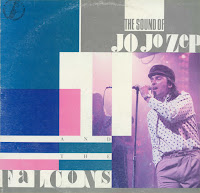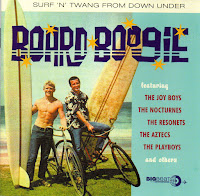
Compilation of the pioneering 60s/early 70s Australian independent Clarion label. A smorgasbord of driving R&B, sunshine pop, studio psychedelia and progressive rock recorded in Perth, Western Australia. Based in Perth, teenager Martin Clarke was working at a local radio station when he converted a spare bedroom into a makeshift recording studio. That modest early venture evolved into Martin Clarke Recording Studios, which opened in 1962 to become Perth's first professional recording facility. By the time the studio purchased a four-track in 1966, Clarke had launched the Clarion label, working with a constant stream of solo singers and beat/R&B groups. With a raised profile after Perth TV personality Johnny Young had a national hit with the Easybeats-penned 'Step Back', Clarion signed a number of promising new acts that included The Valentines (featuring a pre-AC/DC Bon Scott) and Young's TV colleague Robbie Snowden. Clarion went on to have a number of regional and national successes, releasing interesting music into the 70s (British expatriates The Birds and Chalice, plus local progressive rockers Fatty Lumpkin) before Clarke wound down the label and relocated to England.
'The Clarion Set' assembles the pick of the label's roster, with choice selections from the aforementioned acts as well as female-fronted folk rockers Gemini, powerhouse R&B/soul vocalist Ray Hoff, pre-Valentines garage band The Spektors and in-house psychedelic experiment The Vegetable Garden. (Amazon review)
1965-1967
1-1 Russ Kennedy And The Little Wheels– I've Got My Eyes On You (And I Like What I See)
1-2 The Times – Glad, Not Sad
1-3 Ray Hoff & The Off Beats– Bama Lama, Bama Loo
1-4 The Spektors– Gloria
1-5 Johnny Young– Cara-lin
1-6 Mort And The Mobees– Choose Who I Like
1-7 Terry Walker With The The Hi Five– Long Time Gone
1-8 Ray Hoff & The Off Beats– The Uncle Willie
1-9 Glen Ingram With The Hi-Five– Skye Boat Song
1-10 The Kompany– Tell Her No
1-11 Russ Kennedy And The Little Wheels– I've Been Watching You
1-12 Ray Hoff & The Off Beats– My Good Friend Mary Jane
1-13 The Spektors– On My Mind
1-14 Johnny Young– Step Back (demo)
1-15 Russ Kennedy And The Little Wheels– Little Wheel
1-16 Maggie Hammond– Go Laddie
1-17 Glen Ingram With The The Clan – Take This Hammer
1-18 Colin Cook– Cry I Do
1-19 The Valentines – Every Day I Have To Cry
1-20 Ray Hoff & The Off Beats– Looking For My Pig
1-21 Mort And The Mobees– Can't You See
1-22 Maggie Hammond– High Flying Bird
1-23 The Valentines – I Can't Dance With You
1-24 Johnny Young– Good Evening Girl
1-25 Ray Hoff & The Off Beats– Tossin' And Turnin'
1-26 Russ Kennedy And The Little Wheels– Too Much Monkey Business
1-27 Glen Ingram With The The Clan (8)– That It's Me
1-28 Robby Snowden– No One Really Loves A Clown
1-29 Maggie Hammond– You Won't Be Leaving
1-30 Ray Hoff & The Off Beats– Ain't Doin' Too Bad Pts. 1 And 2
1967-1969
2-1 Johnny Young– Hold On
2-2 The Proclamation– King Of The Mountain
2-3 The Valentines – Love Makes Sweet Music
2-4 The Kompany– The Family Way
2-5 The Clan – Peeping Tom
2-6 Chris James – Da Doo Ron Ron
2-7 Ray Hoff & The Off Beats– Love, Love, Love
2-8 Johnny Young– Come On Up
2-9 Robby Snowden– Talkin'
2-10 Glen Ingram– I'll Be Doggone
2-11 The Birds– No Good Without You
2-12 The Valentines – Sookie Sookie
2-13 Johnny Young– Craise Finton Kirk (Royal Academy Of Arts)
2-14 Robby Snowden– Sunshine Rides On A Trolley
2-15 The Troupadours– Come Home Baby
2-16 Colin Cook– You Baby
2-17 Ray Hoff & The Off Beats– I've Got To Get You
2-18 The Soul Purpose – Hip Huggin' Mini
2-19 Robby Snowden– Do You Want To Dance
2-20 The Troupadours– Near To Me
2-21 The Valentines – Peculiar Hole In The Sky
2-22 Johnny Young– Geno Pts 1 And 2
2-23 The Clan – Sunday Afternoon
2-24 Robby Snowden– Just A Little
2-25 The Troupadours– Little Boat
2-26 The Kompany– Little Joe The Boxer
2-27 Strawberry Fair– Come Back And Shake Me
2-28 The Proclamation– Tea And Sympathy (Don't You Worry)
2-29 Johnny Young– Every Christian Lionhearted Man Will Show You
2-30 The Valentines – She Said
2-31 Colin Cook– Riot In Cell Block Number 9
1969-1974
3-1 The Birds– Magic Words
3-2 Chalice – In My World
3-3 Swingshift – Somebody To Love
3-4 The Vegetable Garden– Hypnotic Suggestion
3-5 Gemini – Sunshine River
3-6 Willpower – Soul Finger
3-7 The Soul Purpose – Boogaloo Down Broadway
3-8 Strawberry Fair – Things We Said Today
3-9 The Vegetable Garden– Even Stevens
3-10 Fatty Lumpkin– Got To Get Back T' Nellie
3-11 Chalice – Ebenezer
3-12 The Birds– Dust In My Pants
3-13 Gemini – Twelve Thirty (Young Girls Are Coming To The Canyon)
3-14 Chalice – Mr. Won't You Help Me
3-15 The Soul Purpose – Share
3-16 Willpower – Spinning Wheel
3-17 Swingshift – We Can Work It Out
3-18 The Birds– Rene
3-19 Fatty Lumpkin– Don't Knock My Boogie
3-20 Chalice – Nearly Gone
3-21 Gemini– Butterfly Wings
3-22 Swingshift – Here, There & Everywhere
3-23 The Birds– I See The Rain
3-24 Chalice – Nine To Five Girl
3-25 Fatty Lumpkin – Millionaire






















_front.jpg)


























